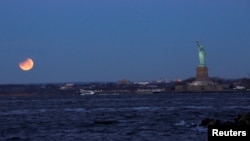Skygazers will have a celestial treat this month, when the longest total lunar eclipse of this century will grace the night sky on the evening of July 27.
NASA says the lunar eclipse will last for 1 hour and 43 minutes with total viability in Eastern Africa and Central Asia. Residents in other parts of Africa and Asia as well those in Europe, Australia and South America will be able to see a partial lunar eclipse.
Skywatchers in North America will not be able to see the rare event and will have to wait until 2020 to experience a total lunar eclipse.
During a lunar eclipse, the moon appears to be red because it lines up perfectly with the Earth and sun such that the Earth’s shadow totally blocks the sun’s light. The moon loses the brightness normally caused by the reflection of the sun’s light and takes on an eerie, reddish glow, giving the lunar eclipse moon the nickname of blood moon.
Scientists say the reason this lunar eclipse is especially long is because the moon is passing almost directly through the central part of Earth's shadow. To compare, it falls just 4 minutes shy of the longest possible time a lunar eclipse could last.
Earlier this year, a lunar eclipse occurred in January at the same time as a super moon, which takes place when a full moon is at its closet orbital point to Earth, appearing brighter and larger than usual. That event delighted moon watchers by being both a blood moon and super moon at the same time.
For those who aren't able to see the lunar eclipse this month, July has another treat in store for skygazers.
At the end of the month, Mars makes a close approach to Earth, reaching the point in its orbit when it is closet to our planet. Mars will appear about 10 times brighter than usual, with peak brightness occurring on July 31.
Everyone in the world will have the possibility to see this celestial phenomena, providing the skies are clear.





